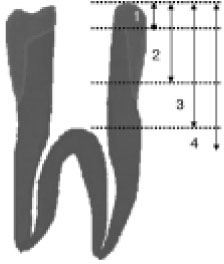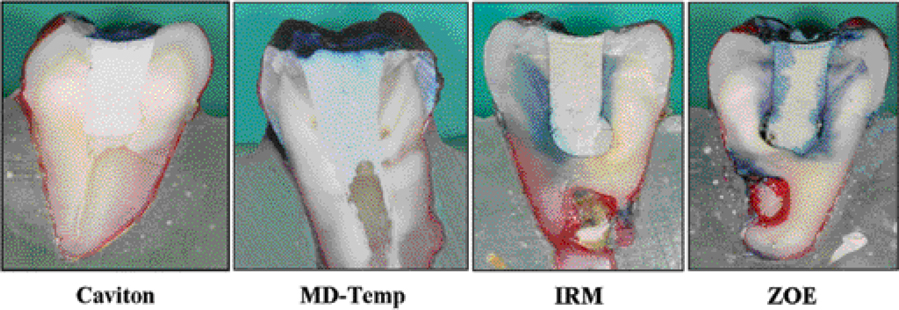J Korean Acad Conserv Dent.
2008 May;33(3):198-203. 10.5395/JKACD.2008.33.3.198.
Microleakage of endodontic temporary restorative materials under dynamic loading
- Affiliations
-
- 1Department of Conservative Dentistry, College of Dentistry, Wonkwang University, Korea. mksdd@wonkwang.ac.kr
- KMID: 2175982
- DOI: http://doi.org/10.5395/JKACD.2008.33.3.198
Abstract
- The purpose of this study was to compare the sealing abilities of four endodontic temporary restorative materials using a methylene blue dye penetration test under dynamic loading. Standardized access cavities were prepared in forty-four intact human permanent molar teeth, and the cavities were restored with Caviton, MD-Temp, IRM, or ZOE. After thermocycling, an intermittent load of 98 N at 1 Hz was applied for 1,000 cycles to the long axis of the functional cusp of each of the teeth, which were immersed in a 1% methylene blue solution. The teeth were split in half, and the linear depth of dye penetration was evaluated according to the criteria. The results were analyzed using one-way ANOVA (p = 0.05) and Duncan's multiple range test. The results demonstrated that Caviton and MD-Temp showed significantly lower microleakage than IRM and ZOE. It was concluded that Caviton and MD-Temp exhibited better sealing ability than IRM and ZOE under dynamic loading.
MeSH Terms
Figure
Cited by 1 articles
-
Coronal microleakage of four temporary restorative materials in Class II-type endodontic access preparations
Sang-Mi Yun, Lorena Karanxha, Hee-Jin Kim, Sung-Ho Jung, Su-Jung Park, Kyung-San Min
Restor Dent Endod. 2012;37(1):29-33. doi: 10.5395/rde.2012.37.1.29.
Reference
-
1. Noguera AP, McDonald NJ. A comparative in vitro coronal microleakage study of new endodontic restorative materials. J Endod. 1990. 16:523–527.
Article2. Saunders WP, Saunders EM. Coronal leakage as a cause of failure in root canal therapy: a review. Endod Dent Traumatol. 1994. 10:105–108.3. Delivanis PD, Chapman KA. Comparison and reliability of techniques for measuring leakage and marginal penetration. Oral Surg Oral Med Oral Pathol. 1982. 53:410–416.
Article4. Jacquot BM, Panighi MM, Steinmetz P, G'sell C. Evaluation of temporary restorations'microleakage by means of electrochemical impedance measurements. J Endod. 1996. 22:586–589.
Article5. Anderson RW, Powell BJ, Pashley DH. Microleakage of temporary restorations in complex endodontic access preparation. J Endod. 1989. 15:526–529.
Article6. Krakow AA, de Stoppelaar JD, Gron P. In vivo study of temporary filling materials used in endodontics in anterior teeth. Oral Surg Oral Med Oral Pathol. 1977. 43:615–620.
Article7. Mayer T, Eickholz P. Microleakage of temporary restorations after thermocycling and mechanical loading. J Endod. 1997. 23:320–322.
Article8. Liberman R, Ben-Amar A, Frayberg E, Abramovitz I, Metzger Z. Effect of repeated vertical loads on microleakage of IRM and calcium sulfate-based temporary fillings. J Endod. 2001. 27:724–729.
Article9. Cruz EV, Shigetani Y, Ishikawa K, Kota K, Iwaku M, Goodis HE. A laboratory study of coronal microleakage using four temporary restorative materials. Int Endod J. 2002. 35:315–320.
Article10. Jung SH, Min KS, Chang HS, Park SD, Kwon SN, Bae JM. Microleakage and fracture pat terns of teeth restored with different posts under dynamic loading. J Prosthet Dent. 2007. 98:270–276.
Article11. Webber RT, del Rio CE, Brady JM, Segall RO. Sealing quality of a temporary filling material. Oral Surg Oral Med Oral Pathol. 1978. 46:123–130.
Article12. Anderson RW, Powell BJ, Pashley DH. Microleakage of three temporary endodontic restorations. J Endod. 1988. 14:497–501.
Article13. Graf H. Bruxim. Dent Clin North Am. 1969. 13:659–665.14. Anderson DJ. Measurements of stress in mastication 1. J Dent Res. 1956. 35:664–670.15. Anderson DJ. Measurements of stress in mastication 2. J Dent Res. 1956. 35:671–673.16. Vail MM, Steffel CL. Preference of temporary restorations and spacers: a survey of Diplomates of the American Board of Endodontists. J Endod. 2006. 32:513–515.
Article17. Widerman FH, Eames WB, Serene TP. The physical and biologic properties of Cavit. J Am Dent Assoc. 1971. 82:378–382.
Article18. Lee YC, Yang SF, Hwang YF, Chueh LH, Chung KH. Microleakage of endodontic temporary restorative materials. J Endod. 1993. 19:516–520.
Article19. Pai SF, Yang SF, Sue WL, Chueh LH, Rivera EM. Microleakage between endodontic temporary restorative materials placed at different times. J Endod. 1999. 25:453–456.
Article
- Full Text Links
- Actions
-
Cited
- CITED
-
- Close
- Share
- Similar articles
-
- Coronal microleakage of four temporary restorative materials in Class II-type endodontic access preparations
- Polymerization shrinkage, hygroscopic expansion and microleakage of resin-based temporary filling materials
- The comparison of microleakage on intracoronal restoration after non-vital bleaching
- Wear, microleakage and plastic deformation of an implant-supported chair-side bar system
- Comparative study of flexural strength of temporary restorative resin according to surface polishing and fabrication methods





